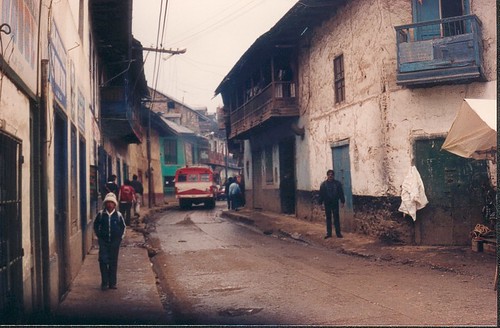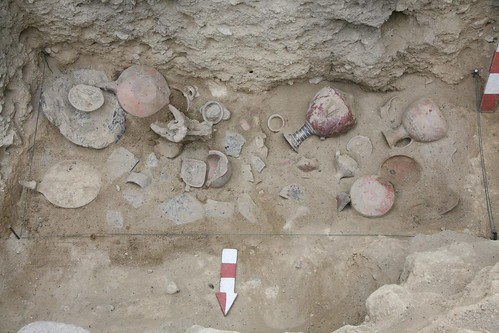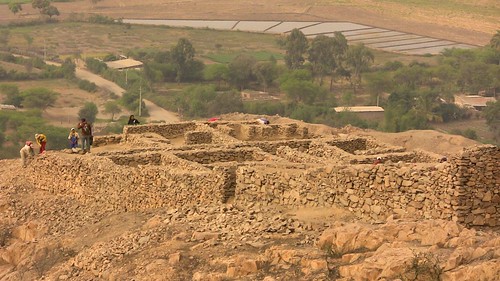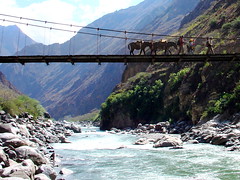Peruvian archaeologist Walter Alva made world news in 1987 when he announced the greatest archaeological find since Tutankhamen in Egypt. When the grave of this Moche ruler was discovered, the archaeological community was amazed to find a burial so intact and yet more amazed at the unbelievable quantity of gold that accompanied this man, the Lord of Sipán.
Category: "Archaeology"
El Brujo Archaeological Complex
Brujo was one of the most important religious sites of the Moche culture. One of the pyramidal structures found there has beautiful preserved high relief murals, still with original paint – making it one of the most important archaeological sites too.
Peru connection with Central America?
A myth still lingers in Northern Peru, said to be a myth passed on by by-gone civilisations, particularly associated with the Sicán but also the Chimú. It goes something like this…
Huaca Arco Iris
One of the most interesting and often-visited Chimú constructions other than the city of Chan Chan is the Huaca Arco Iris, the rainbow pyramid, otherwise known and the dragon pyramid. This Chimú temple gets these names from the decoration the covers all of it walls
Chan Chan
It was the largest city that had existed in South America and remained that way even when it lay in ruins during part of the Spanish colonial period. At 18km2 by some measurements and more than 20km2 including its surrounding agricultural districts, this gigantic city formed the capital of the Chimor kingdom of the Chimú civilisation.
The Chimú and the Kingdom of Chimor
In the aftermath of the collapse of the the Moche civilisation in the late 700s A.D. a new civilisation was born. In the late 800s until the early 1000s the Chimú culture began to establish itself, reaching it’s peak in the 1200s and lasting until the 1490s when they were conquered by the Incas.
Moche: Huaca del Sol y Huaca de la Luna
In the heart of their world, the Moche constructed two truncated pyramids, the gigantic pyramid of the Sun (sol) and the smaller pyramid of the Moon (luna). These pyramids, and the city that spanned between them functioned as their capital.
The Huaca del Sol is by far the largest of the two and is one of two pyramids in Peru thought to possibly be the largest adobe mud-brick construction in the Americas.
The Moche
The Moche (or Mochica) were a civilisation who occupied the northern Peruvian coast between modern-day Lambayeque and Virú and influenced an area that ranged from Huarmey to Piura in the north. They were a collection of peoples with a similar culture and had no central political authority on a grand scale, i.e. they never formed an empire. Primarily farmers and fishers they built irrigation systems to create fertile areas in the desert and created rafts known as the Caballitos de Totora to fish from. But by far their most important legacy was one of art.
Caral – The “Oldest” Civilisation in the Americas
In ancient times, as the peoples of the Nile valley in Egypt and the peoples of the Indus valley in India came together to form cooperative societies, so too did the people of the Supe valley in Peru. In groups of family units of small scale farmers and fishers they began to form systems of government, religion and trade.
An Introduction to Caral
Caral is one of 20 sites thought to be part of the oldest civilisation in Peru and all of the Americas at over 5000 years old. Along the Supe river valley, 5200 years ago, dozens of roaming family groups surviving day to day on what they could find to eat banded together to form a new kind of social group which began pooling their energies and sharing the burden of gathering food and surviving. Here in South America, at the same time as the peoples in the Nile valley were doing the same, one of the first civilisations was formed.
Peru unveils 4000 year old temple
The new discovery filled with murals has been discovered on the north coast.
The ancient temple inside a larger ruin in the Lambayeque valley is home to what is believed to be one of the oldest murals of its kind in the Americas. Video:
Petroglyphs of Pusharo
In his article for the Athena Review, Deyermenjian tells us, “I first encountered petroglyphs in 1984 while my party of highland campesinos and Peruvian adventurers was traversing the Cordillera de Paucartambo, the easternmost range of the high Andes to the northeast of Cusco. We were at an altitude of 13,500 feet when we found ourselves astride a rockhang covered with bas- relief images of llamas and walking humans. All the human figures on the rock were heading in one direction, northeast, toward the tropical forests This site is named Demarcación, whose meaning would doubtless have been understood by Incan peoples of old passing this way”.










